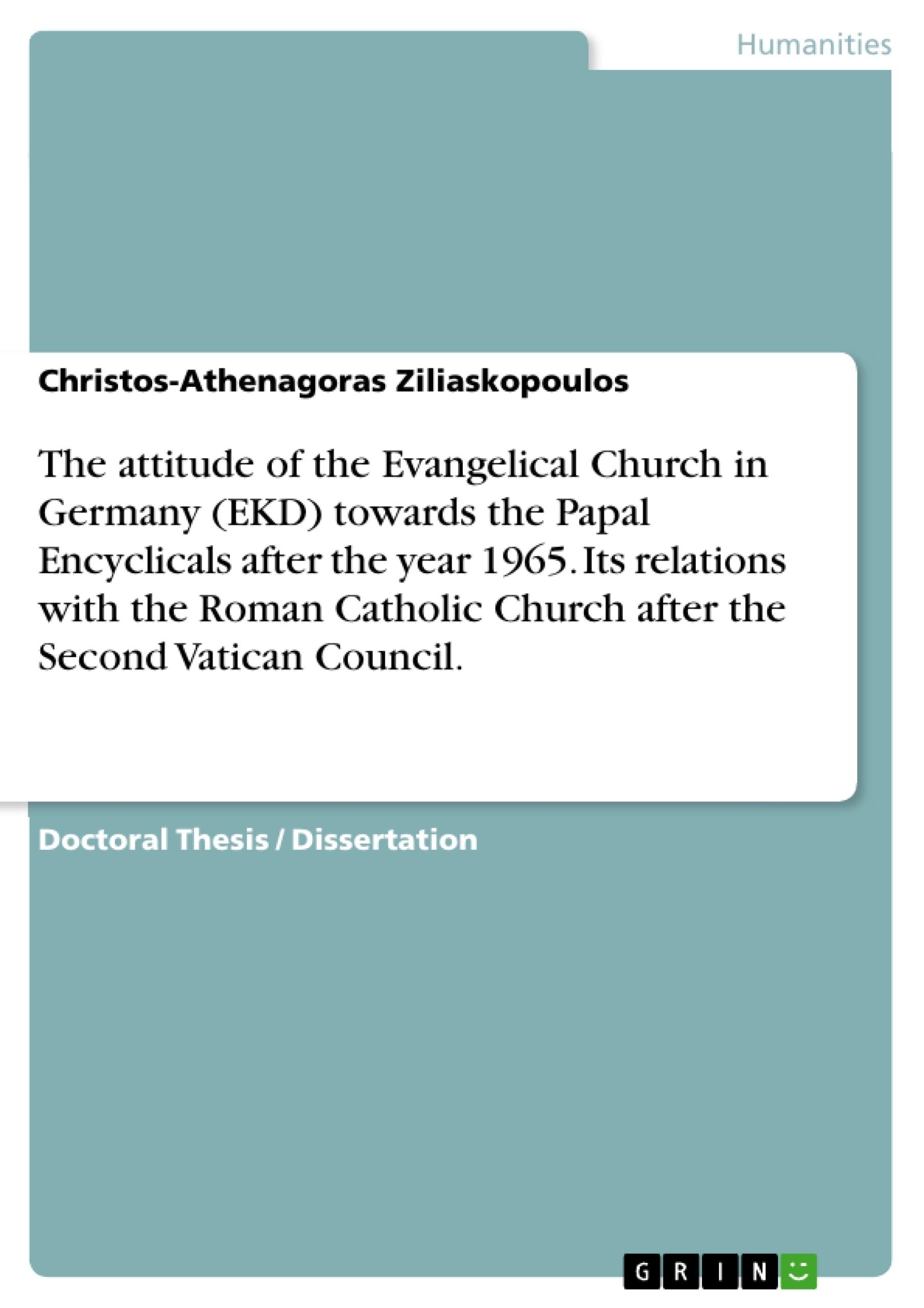In summary the main points of this PhD thesis could be listed as follows:
- The Evangelical Church in Germany and the RC Church in Germany after 1965 are compared by an orthodox theologian.
- The structures of the Churches under investigation and the ecclesiastical institutions or coalitions are presented.
- Texts are studied, especially magazine articles and sources, mostly unknown to the orthodox theologians, for a period spreading from just before the Second Vatican Council up to the present.
- The relations of the protestants and the Roman Catholics of Germany are investigated and interpreted through the attitude of the Evangelical Church of Germany towards the encyclicals of the Pope of Rome after the conclusion of the Vatican Council (1965) and thereafter, as well as through the common papers of the bilateral dialogues and the recent ecumenical movement in Germany.
- The recent developments of the ecumenical movement in Germany and the main issues of the discussions.
- The theological areas of conflict or agreement of both sides on the basis of their texts and their general attitude on socio-moral issues.
- The recent developments on the formation of the ecclesiastical scene in Germany.
- The contribution of Orthodoxy in Germany at present and in the future.
- The formation of a consciousness ‘ecumenical movement of the profiles’ and the mitigation of the conviction for the actual unification of the Churches.
Inhaltsverzeichnis (Table of Contents)
- Abbreviations
- Preface
- Introduction
- A. Delineation of the research
- B. Research method and structure of the thesis
- First Chapter
- 1. The Evangelical Church of Germany (EKD)
- 2. The United Evangelical Lutheran Church of Germany (VELKD)
- 3. The German Bishops' Conference - GBC
- 4. The Second Vatican Council
- 5. Post Second Vatican Council Developments
- 6. The Ecumenical Movement
- 6.1. The Ecumenical Movement and the Roman Catholic Church
- 6.2. The Ecumenical Movement and Protestantism
- 6.3. The Ecumenical Movement in Germany - Arbeitsgemeinschaft Christlicher Kirchen
- 6.4. The Ecumenical Movement in the postmodern era
- Second Chapter - The Theology, Ecclesiology and Sociology of the Papal Encyclicals
- Third Chapter - The attitude of the Evangelical Church in Germany towards the papal encyclicals through the official papers and views of its representatives, commissioners and theologians
- 1. Encyclicals of Pope Paul VI
- 1.1. Before the end of the Council
- 1.2. Following the end of the Council
- 2. Encyclicals of Pope John Paul II
- 3. The encyclicals of Pope Benedict XVI
- Fourth Chapter - The dialogue between the two churches in Germany today
- 1. Construction Augsburg
- 2. Construction Germany
- 3. Developments of the Ecumenical Movement in Germany
- 4. Towards the formation of the EKD as a 'communion'
- 5. The EKD as a ‘Church of freedom’
- Conclusions
- Zusammenfassung
Zielsetzung und Themenschwerpunkte (Objectives and Key Themes)
This PhD thesis aims to explore the stance of the Evangelical Church in Germany (EKD) towards the Papal Encyclicals released after 1965, analyzing its relationships with the Roman Catholic Church following the Second Vatican Council.- The role of the EKD in post-conciliar ecumenical dialogue
- The theological and socio-political context of the Papal Encyclicals
- The reception and interpretation of Papal Encyclicals by EKD representatives, commissioners and theologians
- The evolving nature of the relationship between the EKD and the Roman Catholic Church in Germany
- The impact of the Second Vatican Council on the German church landscape
Zusammenfassung der Kapitel (Chapter Summaries)
- The first chapter introduces the reader to the EKD, its history, and its role in the German church landscape. It also discusses the United Evangelical Lutheran Church of Germany (VELKD), the German Bishops' Conference (GBC), and the significance of the Second Vatican Council. The chapter further explores post-conciliar developments and examines the history and contemporary relevance of the Ecumenical Movement in Germany.
- The second chapter delves into the theological, ecclesiological, and sociological aspects of the Papal Encyclicals, providing a comprehensive overview of their key themes and their impact on the Catholic Church.
- The third chapter analyzes the response of the EKD to the Papal Encyclicals through the official papers, statements, and writings of its representatives, commissioners, and theologians. It examines the EKD's views on individual encyclicals issued by Popes Paul VI, John Paul II, and Benedict XVI, highlighting key areas of agreement and disagreement between the two churches.
- The fourth chapter delves into the evolving dialogue between the EKD and the Roman Catholic Church in Germany, focusing on initiatives such as "Construction Augsburg" and "Construction Germany." It discusses the ongoing developments within the Ecumenical Movement in Germany and explores the concept of the EKD as a "communion" and a "Church of freedom."
Schlüsselwörter (Keywords)
The main keywords of this work encompass the relationship between the Evangelical Church in Germany (EKD) and the Roman Catholic Church in the post-Vatican II era, with a particular focus on the reception of Papal Encyclicals. The study examines key themes such as ecumenical dialogue, theological interpretation, church unity, and the development of the EKD as a distinct entity within the German church landscape.- Quote paper
- Dr. Christos-Athenagoras Ziliaskopoulos (Author), 2012, The attitude of the Evangelical Church in Germany (EKD) towards the Papal Encyclicals after the year 1965. Its relations with the Roman Catholic Church after the Second Vatican Council., Munich, GRIN Verlag, https://www.hausarbeiten.de/document/231947


